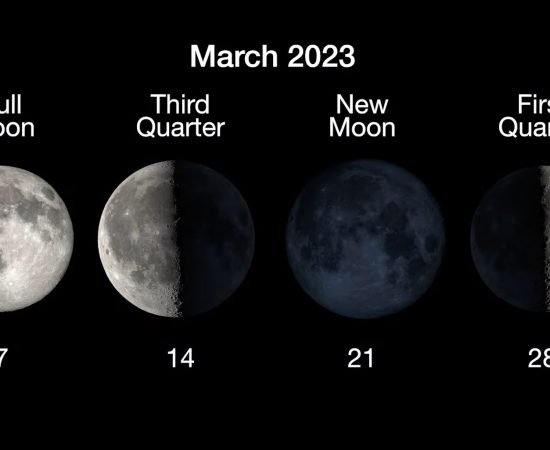What moon phase is it today and when is the next full moon?
One of the most well-known celestial phenomena is the moon’s stages. Every month, we observe the waxing and waning of our lone satellite as it changes from an obvious full moon to a small sliver of a crescent, momentarily vanishes from view, and then rises to full again.
The moon is 99% lit tonight, March 7, 2023, when it is in the full moon period of its lunar cycle. The moon is 15 days old, which indicates that it has completed 15 days of its approximately 30-day period. The full moon in March is also referred to as the “Worm Moon” because of the worms that begin to emerge from the earth as soon as the Northern Hemisphere’s ground thaws.
The pattern in a nutshell:
-On January 6, 2023, the last Full Moon appeared. The Wolf Moon is another name for the full moon in January.
-On January 14, the moon reaches its Third Quarter phase, when it begins to wane toward a New Moon and looks lit on half of its Earth-facing side.
-A new moon will emerge on January 21. The moon will be totally dark on its surface. The new moon period has just begun.
-On January 28, the moon begins its First Quarter phase, during which the Earth-facing side of the moon appears to be lit to half its maximum brightness.
-On February 5, 2023, the next Full Moon will appear.
| Date | Phase of the moon | Time (ET) |
| Jan. 6 | Full Moon | 6:09 p.m. |
| Jan. 14 | Third Quarter | 9:13 p.m. |
| Jan. 21 | New Moon | 3:55 p.m. |
| Jan. 28 | First Quarter | 10:20 a.m. |
| Feb. 5 | Full Moon | 1:30 p.m. |
| Feb. 13 | Third Quarter | 11:03 a.m. |
| Feb. 20 | New Moon | 2:09 a.m. |
| Feb. 27 | First Quarter | 3:06 a.m. |
| Mar. 7 | Full Moon | 7:42 a.m. |
| Mar. 14 | Third Quarter | 10:10 p.m. |
| Mar. 21 | New Moon | 1:26 p.m |
| Mar. 28 | First Quarter | 10:33 p.m. |
| Apr. 6 | Full Moon | 12:37 a.m. |
| Apr. 13 | Third Quarter | 5:12 a.m. |
| Apr. 20 | New Moon | 12:15 a.m. |
The moon’s stages are completely foreseeable because they are brought on by the moon’s orbit around Earth. In fact, we can predict when these stages will occur for the next 50 million years. This is how it will appear tonight:
When no illumination from the moon reaches Earth, we say that the moon is “new”. We refer to this gradual increase in visibility as the moon growing.
A rising crescent can be seen first, followed by the so-called “first quarter moon.” Due to the fact that it truly shows in the night sky as a partially illuminated moon, the term is a little confusing. But if you give it some thought, you can divide the moon into four quarters: two on the side that faces the Earth, and two on the other. Skywatchers can see a quarter of the complete Moon lit during a first quarter moon.
A rising gibbous moon, which is halfway between a first quarter and a full moon, will appear after that. Because of the way it appears in the night sky, it derives from an ancient Middle English term meaning “hump.” The moon is said to start waning after it is full. Thus, a fading gibbous moon appears first, then a last quarter moon, a declining crescent, and finally another new moon.
According to the Lunar and Planetary Institute, this sequence of stages completes in 29.5 days.
WHY DOES THE MOON HAVE PHASES?
Dhara Patel, a space specialist at the National Space Centre in Leicester, United Kingdom, stated that the moon is only visible to us because it is radiating the sun’s light. “The sun always lights up half of the moon wherever it is in its orbit around the Earth.” Live Science was informed by Patel. The same is true of the Earth; half of us live in the day and the other half in the night.
Additionally, the same side of the moon always confronts Earth. “Synchronized rotation” refers to the fact that the moon rotates on its center and circles the Earth at the same rate. On occasion, the lit side of the moon is also the side that faces Earth. In that scenario, a full moon is visible. When the moon is located on Earth’s opposing side of the Sun from the Sun, this occurs. Due to the Moon’s inclination in relation to Earth, sunlight is typically not blocked. When Earth does obscure the light, we see a moon eclipse.
The Sun’s corona, which is only visible during a complete solar eclipse, is displayed as a canopy of white flares from the surface when the sun is covered by the moon. (Photo courtesy of NASA/Carla Thomas)
We see a New Moon or no light at all when the moon is directly between Earth and the sun, which fully illuminates the side pointing away from us. Once more, the moon rarely obscures our view of the sun due to the inclination of its path. We rarely witness sun eclipses when this happens.
According to Sky and Telescope, we can see intermediate phases like crescent, quarter, and gibbous moons when sunlight is partly landing on one side of the sky and partially on the other.(opens in new tab).
WHAT IS THE DARK SIDE OF THE MOON?
The phrase “dark side of the Moon” is frequently used to describe the side of the moon that always faces away from us; this is possibly owing in part to the Pink Floyd record of the same name. Despite being widely used, Patel believes that the expression should not be used. The moon has a far side, not a black side, claimed Patel. Only during a Full Moon, when our side is entirely lit, is that far side totally black. The far side is at least partially lit at all other hours, she claimed.
WHAT IS A LUNAR OR MOON CALENDAR?
Many various civilizations and communities have used the moon to determine their calendars throughout human history, according to Patel. The term “moonths” refers to the division of years into months in the Gregorian calendar. The 29.5 days it takes for the moon to pass through its stages is very close to the duration of a calendar month on average.
For instance, the moon is used to determine the date of Easter, a holiday celebrated by Christians. The first Sunday following a full moon that happens on or after the Spring equinox is when Easter Sunday falls. Easter is the following Sunday if the full Moon occurs on a Sunday.
The moon also serves as the basis for the Jewish and Islamic schedules.
The moon continues to be the basis for the Chinese, Vietnamese, Hindu, and Thai schedules as well. In order to keep track of time and the seasons, the full moon in each month is assigned a specific name in some societies, according to Patel.
ADDITIONAL RESOURCES
- Learn more about the phases of the moon using this incredible interactive website from NASA.
- Hear about the moon’s violent birth and how the phases of the moon have shaped our lives in this video from National Geographic.
- And for an extra-deep dive, find out everything you ever wanted to know about Earth’s omnipresent satellite in the book “The Book of the Moon: A Guide to Our Closest Neighbor” (Abrams Image, 2019).




